An Individual Learning Plan (ILP) is a personalized educational strategy designed to address the unique needs, skills, and learning objectives of an individual. It serves as a roadmap for…
continue reading
8+ Sample Exit Strategy Business Plan
-
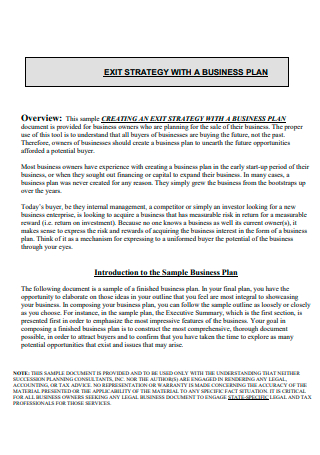
Exit Strategy Business Plan Template
download now -
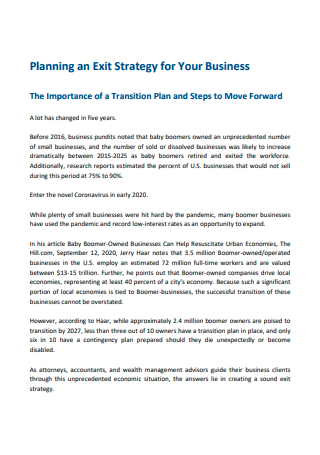
Exit Strategy Business Planning in PDF
download now -
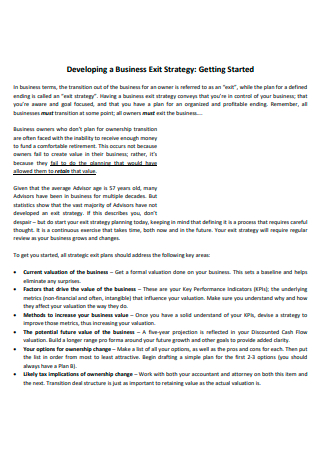
Printable Exit Strategy Business Plan
download now -
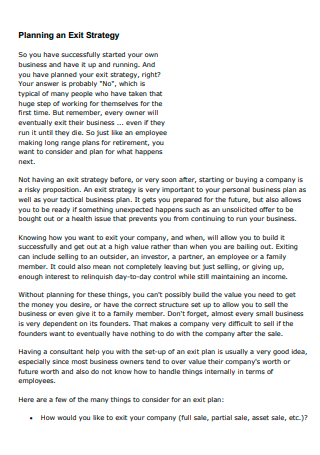
Exit Strategy Business Plan Example
download now -
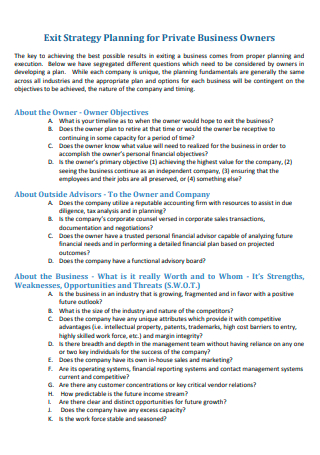
Exit Strategy Private Business Owners Planning
download now -
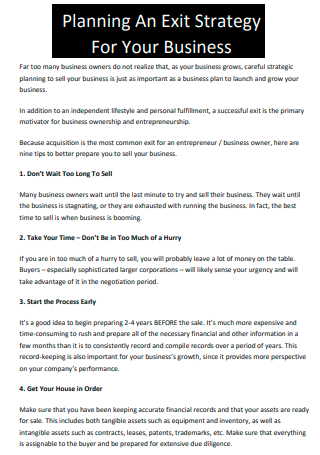
Printable Exit Strategy Business Planning
download now -
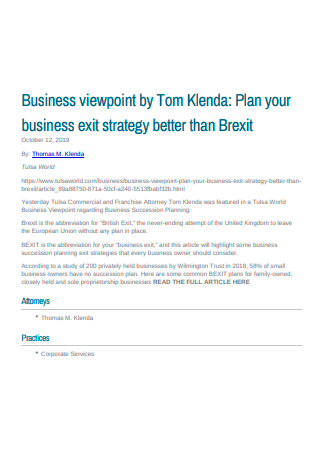
Sample Exit Strategy Business Plan
download now -
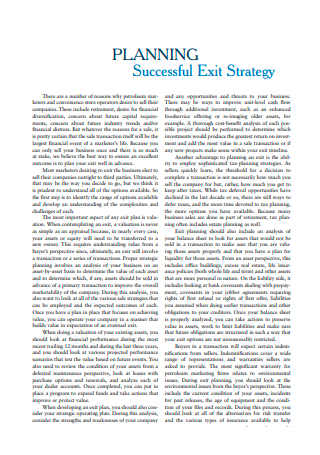
Successful Exit Strategy Business Plan
download now -
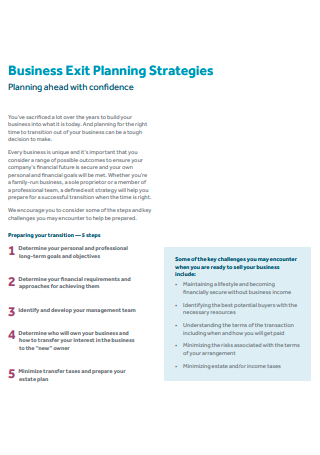
Standard Exit Strategies Business Plan
download now
What Is an Exit Strategy Business Plan?
An exit strategy business plan is a process by which a business owner strategically plans to sell or give up his or her business stake to other companies or investors from different companies as a way of closing down the business. It can also be in the form of the owner selling his shares in stock to the other shareholders. An exit strategy business plan is usually considered as a contingency plan that reduces the loss of the owner by way of liquidating his business. On the other hand, if the business was doing good, an exit strategy could create a considerable profit for the owner, such that the revenue gained from selling the business will be used by the owner to start a new business venture.
An exit strategy is generally part of a business contingency plan when the business is just starting up, in anticipation of potential risk and loss in terms of profit and operation. It is an important part of the business plan that investors or financial institutions look into before they approve or provide the startup capital for the business. Creditors would want to know what is the owner’s backup plan or how their money will be protected in the event the business fails.
4 Types of Exit Strategies Business Owners Should Know
Before doing an exit strategy, the owner should properly assess the business’s conditions and all other aspects surrounding it with the help of licensed financial advisors. If an exit strategy was created at the onset and is part of the business plan, the owner should consider if the chosen type of exit strategy plan is still the best viable and feasible option. There are several different types of exit strategies to choose from, depending on which of the strategies is more compatible with the business to bring in more gains or profits. Here are some of the exit strategies that are most commonly utilized by business owners.
How to Create an Exit Strategy Business Plan
Knowing when it’s time to go and how to leave the business is equally important as when you started planning and setting up your business. An exit strategy business plan is an important tool when creating a process on how to profitably exit or close down a business, or at least minimize the losses if the business is no longer gaining momentum. There is no fixed rule when it comes to formatting an exit strategy business plan. So long as you understand all the essential elements that need to be included, your exit strategy could be as equally effective as any successful business plan. An exit strategy business plan can be created at the time when there is a need to close down the business, while the exit strategy method can be identified at the onset as part of the startup business plan. Note that the whole exit strategy business plan can be presented to two types of audiences: the shareholders and other company major investors; and the potential buyers for the business. Below are the common steps that are taken when creating an effective exit strategy business plan.
Step 1: Executive Summary
An executive summary summarizes what the exit strategy business plan is all about. Its main goal is to capture the reader’s attention and to invite them all the way to read through the whole document or presentation. In an exit strategy business plan, the executive summary should explain the reason why there is a need to liquidate, exit, or close down the business. Here, you list down the specific reasons, as well as an outline of the exit strategies methods you’re planning to use. The executive summary can also function as a mission statement, stating that the reason for coming up with an exit strategy business plan is to realize a profit margin through liquidation of the company within a specified time.
Step 2: Business Narrative
Describe the overall business structure, its size, manpower, facility, operation, financial status, et cetera. Include the key details, such as the products or services being offered, what makes the brand unique from its competitors, and how long has the company been operating. Other details you can include are the pricing for each product, their lifespan, their manufacturing, their distribution process, as well as any patents or proprietary information involved in the making of the product.
Step 3: Provide a Current Market Analysis
Part of doing an exit strategy is that you have to be transparent about the present market condition that your business is in. You need to present a market analysis, and to do so, you can do a SWOT analysis presentation. SWOT stands for Strength, Weaknesses, Opportunities, and Threats. Strengths are those characteristics that make your company unique and stand out from the competitors. It could be in the form of having a strong customer following, strong branding, unique product concept, et cetera. Weaknesses are those aspects that your business lacks or need further improvement, such as having a weak product concept, weak sales strategy, lack of supply and resources, lack of funds, and so on. Opportunities are those that the company can take advantage of to further their business, like taking advantage of the latest trend in social media platforms to perform marketing strategies, taking advantage of the latest cut in taxes for importing or exporting of production supplies, or taking advantage of the reduced rate in the price for shipping and transportation. Threats are those factors that could negatively impact or potentially harm the business operation, such as extreme weather changes, the emergence of new competitors, increase in the cost of materials for production, et cetera. This overall market analysis will provide the backbone behind why you need to come up with an exit strategy plan.
Step 4: Exit Strategy
This is the section where you indicate the chosen strategy or approach to exiting the business. In the beginning, when the business was just starting up, an exit strategy method is already considered part of the contingency plan that’s ideally included in the business plan. There are a lot of different exit strategies that the business can choose from, depending on which strategy the business can most profitably gain from, or at least lessens the impact of financial losses, or to be able to have business continuity. Those common strategies that we have mentioned include mergers and acquisitions, liquidation, IPO or Initial Public Offerings, or selling the business to friends or family. Careful consideration should be given when choosing an exit strategy, or at least should be aided with a licensed professional financial advisor.
Step 5: Financial Statements
An exit strategy business plan should reflect the current and accurate financial condition of the company, listed down in the financial statement. It should include the budget or capital versus the cost expenditures, as well as present any existing debts. This will be the basis for computing how much loss will be realized or profit will be gained if the company goes into liquidation. This will also be the basis for the total amount of money or value of shares that each shareholder will be receiving.
FAQs
What are the common reasons why an owner decides to sell his or her business?
Selling the business is an option due to the following reasons: the expenses are more than the profit; the owner is ready to retire; business partners mutually decide to dissolve partnership; for business expansion or creation of a new business venture; and existing threats in market that the business is no longer able to keep up, such as lacking in resources for production supply, or having no contingency plan in place when unforeseen circumstances happen such as fire or an earthquake that greatly affected the whole business structure.
How do you deal with your customers in the event you decide to close your business?
Having a positive customer relationship is important, even after you have shut down your business. As a way to help them through the transition period, you can start reaching out to your customers, especially your key customers, as a way of informing them ahead of time that your business will be closing. Make sure to address and resolve any existing customer issues so that your business can still have a positive review. And if necessary, or in the case of merger and acquisition, introduce to them the new company that will be taking over, and/or if there will be any possibility of changes in products, services, or prices. Giving your customers a heads up will make them feel valued for their loyalty and patronage.
What are the factors that need to be considered when creating an exit strategy plan?
First, the overall business structure and size need to be considered. Next is the current economy or the market condition from which the business is planning to exit from. An effective and compatible exit strategy method should also be considered. Last but not least, the overall timeline for implementing the exit strategy plan.
John realizes that he needs to file soon for bankruptcy if he doesn’t come up soon with a good exit strategy plan. Company A has been experiencing more losses than gains, up to the point where they are no longer able to maintain the operating expenses, as well as pay up their existing debts from creditors. What John needs to have is a good business plan, an exit strategy business plan.
If you’re looking for a business plan template to help you create that effective exit strategy plan, look no further. We have loads of business plan templates to choose from, and more importantly, we also have several templates of the exit strategy business plan. Download our template now, and see for yourself how convenient and easy it is to create that effective exit strategy business plan.

